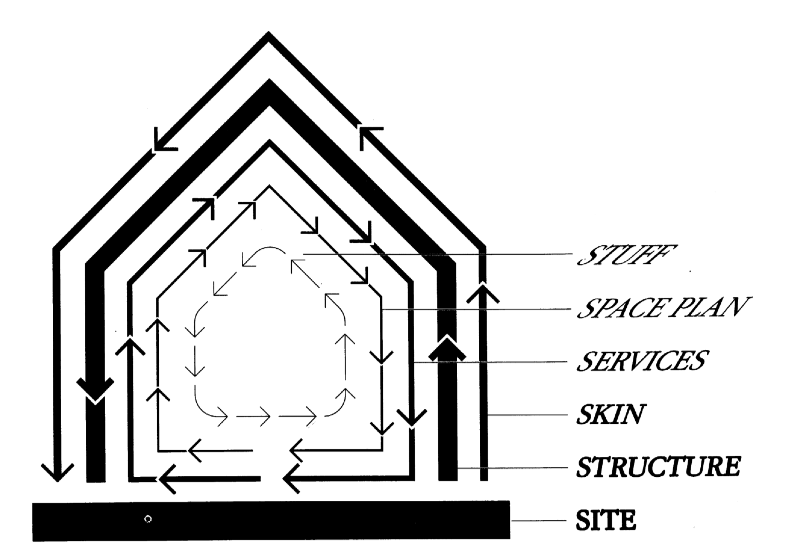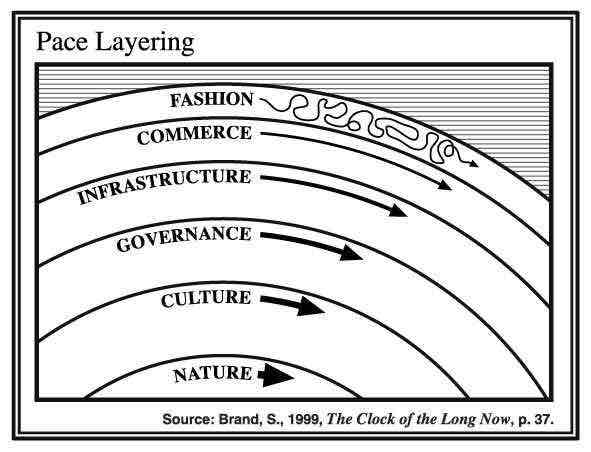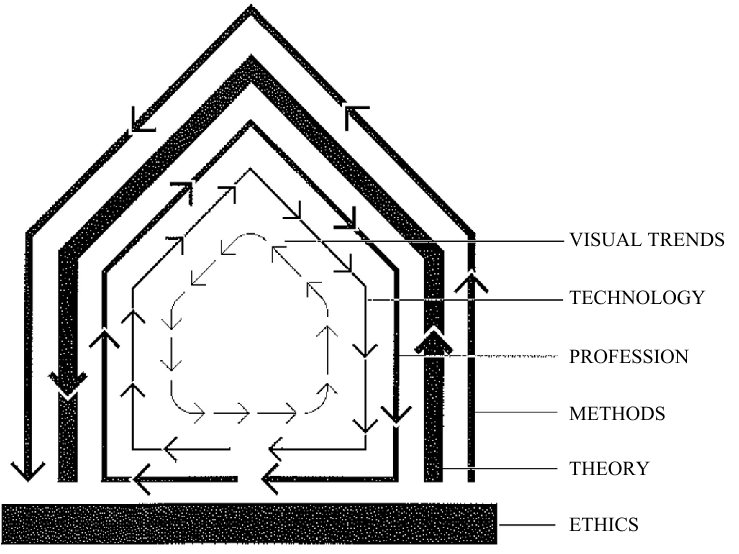The Shearing Layers of Graphic Design Education
I often get asked — in various interviews, personal conversations, for roundups — about my favorite books. The stock answer I’ve given for years is Stewart Brand’s 1994 book How Buildings Learn. It’s a book that I felt like I was marking up nearly every page the first time I read it, probably fifteen years ago at this point. Right on the second page, for example, Brand writes:
The word “building” contains the double reality. It means both “the action of the verb build” and “that which is built”—both verb and noun, both the action and the result. Whereas “architecture” may strive to be permanent, a “building” is always building and rebuilding. The idea is crystalline, the fact fluid.
I’ve quoted this (and adapted it, replacing the work “building” with “design”) more times than I can count. It’s become central to my own work and thinking in and around design. That single paragraph, honestly, is why the book feels seminal in my personal canon.
But there’s another framework Brand introduces that has similarly shaped my worldview and become a metaphor I apply to everything I can: shearing layers.

Originally coined by architect Frank Duffy to describe how a building is composed of layers of change, Brand expanded the concept to six elements that all buildings have; with each one changing at a different pace: Site, Structure, Skin, Services, Space Plan, Stuff. The Site, for example, never changes: a building is always situated in the same place. It’s structure, also, is fairly consistent but might see slow changes over time: removing a wall, adding an addition, etc. The space plan is easier to change and perhaps calls for more rapid variation: moving furniture and rearranging rooms. Finally the Stuff layer is always in flux, moving a book from the shelf to the table or dropping off your keys when you walk inside. The thesis here, and of Brand’s book, is that buildings are not finished once they’ve been “built” but rather is always rebuilding1, each layer moving at a different pace.
I’ve found shearing layers to be a fruitful metaphor for a wide range of applications. For years, I used shearing layers when talking about branding with my students as a way to think about what branding elements need consistency (fonts, colors, for examples) and where you can add variety (outputs, photography). Brand further adapted the concept in his 1999 book, The Clock of Long Now, with “Pace Layers” which shows the progression of societies: the fast layers innovate and the slower layers stability. “The whole combines learning with continuity,” he writes.

I’ve been thinking about design curriculums lately and once again found shearing layers to be a powerful way to think through both what we could teach in design programs and how to set up students for a long career — “a continuity of learning”. Here’s a quick edit I made to Brand’s diagram, replacing his shearing layers with the elements of a design education:

In this diagram, we can think of each layer as an important element of a design program. Like Pace Layering, the inner labels stabilize, remaining mostly consistent while the our layers change faster. From the inside out, some quick descriptions:
- Ethics: why we do what we do
- Theory: how we think about what we do
- Methods: how we do what we do
- Profession: what the field wants us to do
- Technology: the tools we use
- Visual Trends: the surface of what we do, what the work looks like
It is helpful for me to think about design education in this way because too often, I think, design curriculums (at least graphic design curriculums) spend too much time on the outer layers and not enough time on the base layers. Curriculums are redesigned and realigned depending on visual trends, technological innovations, and professional needs. Consider the debates about whether designers should code from fifteen years ago (technology) or whether students should be using Adobe or Figma. When I first started teaching, it seemed every studio wanted motion designers and suddenly design programs were introducing motion design classes to their programs. Before that it was apps and before that it was HTML. Or think about how every digital designer’s portfolio looks the same with interface after interface of rounded rectangles, sans-serif typography, and shades of blue. It seems to me building a design curriculum around those three outer levels is a fool’s errand. The pace of change is too fast that the program will quickly fall behind and the energy to update and shift will impede, rather than promote, innovation.
That’s not to say these layers are not important. They are! Design programs must be on top of the latest technological innovations and the standard tools of the industry. They must know what the field needs and be on top of visual trends. But these are not what a curriculum is based on. Instead, I propose building design curriculums around the slower layers, what I’m calling ethics, theory, and methods.
We can talk all we want about digital vs. print design or UX versus book design but at the end of the day, the processes are largely similar: behind the output the design process is about creating an experience, an exchange of information. Methods include research, prototyping, process, and thinking. After this, design theory provides students with an intellectual framework about how design exists in the world. This might include design history and theory but also adjacent fields like media theory and political economy. This, of course, touches on the outer layers: students could be equipped to understand where trends come from and how they evolve. They can critically engage with new tech instead of blindly following Silicon Valley.
Finally, what would a design program look like built not around technology or outputs but around ethics? Every project, every class, would be grounded in thinking about environmental concerns, capitalism and consumerism, power and inequality. Students would question who gets left out of processes and who doesn’t have access to technology. They’d have to consider how the work is paid for and who is benefitting.
We’re in a moment of profound cultural and technological change and this forces design program to adapt too. Instead of grabbing on to the next shiny object, the trendy tech, this is also an opportunity for design programs to reaffirm design’s position in the world and why we think what we do has value. In building a design curriculum around ethics, around theory, and around methods, we can ensure the next generation of designers are equipped to handle the increasing rate of change of the outer layers. This, perhaps, is the paradox: by embracing the slower layers, students can better adapt as they tackle the outer.
-
I’m reminded of Bruno Latour’s maxim here too, that every design is really a redesign. ↩
